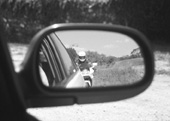Seen and not hurt
The Highway Code could be putting motorcyclists at risk according to recent research at Sussex. The Highway Code recommends that motorcyclists wear bright clothing and apply headlights in the daytime, so that other road-users may see them more easily. However tests carried out by Dr. Graham Hole, Martin Langham and Lisa Tyrrell (COGS) have found that most motorcycle accidents occur because road-users are not trained to look out for motorcyclists. Moreover, they have found that riders' efforts to make themselves more visible could in fact have the opposite effect.
They say the emphasis should be placed upon training drivers to be more vigilant, rather than urging bikers to try to make themselves more visible. Martin Langham said: "The Highway Code's advice could make riders believe they are more visible than they actually are, which is potentially very dangerous."
Bright clothing can act as camouflage and instil a false sense of security in the riders because the bright clothing which allows them to be seen against a dark backdrop may also be the cause of a driver failing to see them in bright conditions. Similarly tests have shown that the use of headlights in the daytime by the majority of motorcyclists might be endangering a minority who don't use them. This is because motorcyclists not using their headlights during the daytime may not be seen by drivers even though they are clearly visible.
 In other words: what the eye sees and what the brain thinks the eye is seeing are not necessarily the same. Consequently some drivers may unconsciously use a single headlight as a cue for a motorcyclist; scanning for the lights rather than the motorcyclist.
In other words: what the eye sees and what the brain thinks the eye is seeing are not necessarily the same. Consequently some drivers may unconsciously use a single headlight as a cue for a motorcyclist; scanning for the lights rather than the motorcyclist.
Since it is impossible for motorists to assimilate all visual information when driving, they rely instead upon navigational 'cues': shapes, colours, motion, etc. In this way the brain effectively tells itself what to look for. On the whole, such a system is highly efficient. But problems can arise. Graham Hole and his colleagues have found that working on the basis of expectations could lead to accidents when the situation that a driver thinks he encounters does not match the true situation in front of him. Consequently even if a motorcyclist is putting out a strong visual signal he may go undetected if this signal is not a recognised cue.